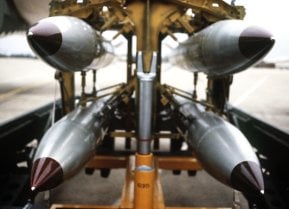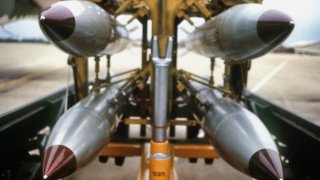Japan Is Destined to Have Nuclear Weapons
“[The Japanese have] a pretty clear view of where they’re going; they’re heading towards becoming a nuclear power in five years.” - Henry Kissinger, April 2023.
My country, Japan, has reached a historic crossroads: It must develop nuclear weapons because it really does not have a choice.
If one is realistic about the current geopolitical situation in Asia, there is only one issue that matters: The circumstances that served Japan so well following its defeat in World War II no longer exist. A nuclear China is an ever-expanding menace, flexing its muscles well beyond its borders. North Korea has a growing arsenal of nuclear weapons and shows no signs of tempering its hostility toward its neighbors. Most of all, the American “nuclear umbrella” that allowed us so many years of peace and prosperity under Washington’s military protection is increasingly frayed, probably irreparably. A long list of government officials and academic experts has always viewed America’s guarantees of protection against enemies as the foundation of its security. What policymaker in Japan, looking at the present disarray in Washington, can still take those guarantees for granted?
In the years after World War II and at the height of the Cold War, Japan was the bulwark of the American presence in Asia. The two countries were mutually committed to offsetting China’s rise and countering the spread of Communism. Former Prime Minister Yasuhiro Nakasone declared that Japan and the United States shared an “inseparable destiny.”
Looking back now, one can see that there were always cracks and potential ruptures in that “destiny,” even if politicians papered them over. After the war, Japan, not unreasonably, became an international voice for the cause of peace. Written into its Constitution is a renunciation of war and the use of force to settle disputes. To some—over one-third of the public, according to one poll—such language had transformed Japan from a militaristic state into a pacifist nation with a special mission in the world. However, others, including influential figures in the government, interpreted the Constitution as giving Tokyo the leeway to develop nuclear weapons if necessary. But the issue never developed into a genuine debate. People in Japan refused to discuss it.
As the only country to be victimized by atomic bombs, many Japanese were passionately opposed to their use—“Never again!”—or even their development. John Foster Dulles referred to this as a “nuclear allergy,” a phrase he used in 1954 after a fishing boat, the Lucky Dragon, was exposed to radiation from an American thermonuclear test on Bikini Atoll. The number of people affected was minuscule compared to the thousands of dead in Hiroshima and Nagasaki. Still, it was as if all the emotions that had been tamped down since 1945 suddenly exploded. Within a month, the Diet passed a resolution opposing nuclear testing, while a public petition collected the signatures of more than half of the country’s registered voters in support of the resolution. (The incident also spurred the production of the movie “Godzilla.”) Japan was on its way to developing an international reputation as “the peace nation,” a designation that made its citizens proud. And in the years that followed, Japan introduced dozens of resolutions to the United Nations General Assembly calling for the abolition of nuclear weapons.
Admittedly, there was incontrovertible hypocrisy between Tokyo’s opposition to nuclear weapons while it sheltered under the American nuclear umbrella. In 2016, New Zealand offered a UN resolution declaring that nuclear weapons should never be used under any circumstances. It attracted more than 100 cosponsors, Japan included. At the same time, eighteen nations backed a competing statement arguing that the use of nuclear arms might be necessary for reasons of national security. The two declarations were clearly incompatible. Japan was the only nation to sign both. But such contradictions didn’t bother the pacifist-minded public. Discussion of nuclear weapons was the third rail of Japanese politics. “Peace education” was required in public schools, and even the Ministry of Foreign Affairs funded anti-nuclear programs. Any leader who suggested a change in policy was bound to pay a political price.
Not even China’s first successful nuclear test in 1964 had much of an impact on public opinion—though it did bring home to many Japanese political leaders just how dependent the nation was on America and its bombs. Perhaps the majority of the Japanese people could shield their eyes and remain complacent. However, government officials charged with maintaining national security could not afford to ignore the Chinese threat. A split was emerging between elite opinion and the popular temper that would only grow in the years to come. It seemed that Japan’s longstanding anti-nuclear stance had become dependent on people who refused to adapt to a changing international situation, who had learned nothing and forgotten nothing.
Prime Minister Eisaku Sato personified the division. After the Chinese test, he lamented his countrymen’s policy blinders and said the public had to be educated about the new realities. This would take time, he thought. Meanwhile, Sato took the only path open to him. He traveled to Washington to plead with President Lyndon Johnson to reaffirm America’s commitment to Japan’s defense. There was clearly something hat-in-hand, undignified, about Sato’s supplications—the U.S.-Japan alliance was never one of equals—but he did have one trump card up his sleeve. If Johnson didn’t supply the needed reassurances, he warned, Japan would have to consider developing its own nuclear weapons. In 1964, public opinion wouldn’t have countenanced that, and Sato no doubt knew it. Yet, the threat was convincing enough and disruptive enough to get Johnson’s attention. He issued a statement, reiterating it in 1967, that the United States was prepared to prevent China from employing nuclear weapons.
That was what Sato had hoped for, and it allowed him to then tack in the opposite direction. When he came home, he transformed from a leader for national security to a leader for peace. In December 1967, he enunciated what would become the foundation of Japan’s nuclear policy ever since: the “Three Nonnuclear Principles.” Japan would not develop nuclear weapons; It would not possess nuclear weapons; It would not allow nuclear weapons to be stationed on its territory. In private, Sato allegedly called the promises “nonsense.” Later, the always ambivalent (or two-faced) Sato added a fourth pillar, in essence declaring that Japan would adhere to the Three Principles as long as it retained confidence in America’s nuclear umbrella. For his efforts, he received the Nobel Peace Prize in 1974.
Indeed, Washington’s reliability and its nuclear umbrella have always been at the heart of Tokyo’s security policy. Posed in its simplest terms, the question is: Would America be willing to risk the destruction of Los Angeles to protect Tokyo? As the Chinese and the North Koreans expand their nuclear capabilities, the question has taken on lethal pertinence. As the question grows in importance for Japan’s future, one is forced to look back at the U.S.-Japan alliance and ask how strong it is or has ever been. Japan has always been the junior partner. Washington makes a decision, and Tokyo accommodates and adapts. But should it be satisfied to remain a junior partner?
A historic turning point in the relationship arrived in the early 1970s when Richard Nixon went to China and took the United States off the gold standard. These were profound “shocks” to Japan’s political and economic positions. Crucially, they demonstrated to Tokyo that Washington was prepared to pursue what it perceived to be its national interest, even if it damaged the interests of its allies. To be sure, the internationally-minded Nixon offered reassurances to the Japanese government—and it adapted. Then, America abandoned its ally in South Vietnam, and Japan adapted. The United States also turned its back on allies in Iraq and Afghanistan. Again, Japan adapted. Washington failed to support Tokyo when North Korea kidnapped Japanese citizens. It drew a “red line” in Syria and refused to uphold it. It withdrew from the Trans-Pacific Partnership, the Kyoto Protocol on climate change, and the nuclear agreement with Iran. It made promises to defend the integrity of Ukraine, then failed to risk the lives of its own troops after the Russian invasion. Just how much can Tokyo trust any promises coming out of Washington?
What’s more, Japanese doubts are double-edged. If they have serious concerns about the United States doing too little, they also worry about it doing too much. In the years since the collapse of the Soviet Union, the United States has proved to be impetuous and sanctimonious, canceling agreements with Russia, invading Iraq and Afghanistan, and intervening in Libya with little consideration of the long-term consequences. By tying their security to the decisions of impulsive and unreliable leaders in Washington, the Japanese are allowing themselves to be whipsawed. This is not a condition any country should have to live with, certainly not one as powerful as Japan.
Perhaps no other issue reveals the uncertainty and weakness of the U.S.-Japanese alliance at present as the vulnerability of the Senkaku Islands in the East China Sea, claimed both by Japan and China (where they are known as the Diaoyu Islands). A full-scale attack on Japan by China is unimaginable, but gradual encroachments that shift the balance of power in the Senkakus are another matter. This dispute has continued for decades. Yet, in recent years, as the nuclear-armed Chinese have grown stronger militarily, they have become more assertive, sending Coast Guard patrols into what they claim are “Chinese territorial waters,” and scrambling their aircraft overhead. There are about two dozen Chinese military bases within range of the Senkakus, but only four U.S. and Japanese bases.


